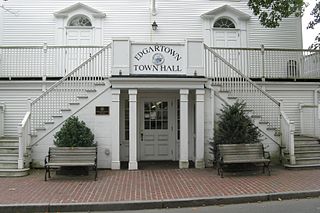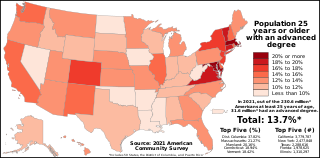Related Research Articles

The United States had an official estimated resident population of 333,287,557 on July 1, 2022, according to the U.S. Census Bureau. This figure includes the 50 states and the District of Columbia but excludes the population of five unincorporated U.S. territories as well as several minor island possessions. The United States is the third most populous country in the world. The Census Bureau showed a population increase of 0.4% for the twelve-month period ending in July 2022, below the world average annual rate of 0.9%. The total fertility rate in the United States estimated for 2022 is 1.665 children per woman, which is below the replacement fertility rate of approximately 2.1.

Dukes County is a county located in the U.S. state of Massachusetts. As of the 2020 census, the population was 20,600, making it the second-least populous county in Massachusetts. Its county seat is Edgartown.

Perrysburg is a city located in Wood County, Ohio, United States, along the south side of the Maumee River. The population was 25,041 at the 2020 census. Part of the Toledo metropolitan area, the city is 12 miles (19 km) southwest of Toledo. It served as the county seat from 1822 to 1868, and it is still the second-largest city in Wood County. After Bowling Green was designated as county seat, it surpassed Perrysburg in size.

The United States census of 2000, conducted by the Census Bureau, determined the resident population of the United States on April 1, 2000, to be 281,421,906, an increase of 13.2 percent over the 248,709,873 people enumerated during the 1990 census. This was the twenty-second federal census and was at the time the largest civilly administered peacetime effort in the United States.

The American Community Survey (ACS) is an annual demographics survey program conducted by the U.S. Census Bureau. It regularly gathers information previously contained only in the long form of the decennial census, including ancestry, citizenship, educational attainment, income, language proficiency, migration, disability, employment, and housing characteristics. These data are used by many public-sector, private-sector, and not-for-profit stakeholders to allocate funding, track shifting demographics, plan for emergencies, and learn about local communities. Sent to approximately 295,000 addresses monthly, it is the largest household survey that the Census Bureau administers.
The Current Population Survey (CPS) is a monthly survey of about 60,000 U.S. households conducted by the United States Census Bureau for the Bureau of Labor Statistics (BLS). The BLS uses the data to publish reports early each month called the Employment Situation. This report provides estimates of the unemployment rate and the numbers of employed and unemployed people in the United States based on the CPS. A readable Employment Situation Summary is provided monthly. Annual estimates include employment and unemployment in large metropolitan areas. Researchers can use some CPS microdata to investigate these or other topics.

The Survey of Income and Program Participation (SIPP) is a statistical survey conducted by the U.S. Census Bureau. The SIPP is designed to provide accurate and comprehensive information about the incomes of American individuals and households and their participation in income transfer programs.

White Americans are Americans who identify as white people. This group constitutes the majority of the people in the United States. According to the 2020 census, 71%, or 235,411,507 people, were White alone or in combination, and 61.6%, or 204,277,273 people, were White alone. This represented a national white demographic decline from a 72.4% white alone share of the U.S. population in 2010.
The Consumer Expenditure Survey is a Bureau of Labor Statistics (BLS) household survey that collects information on the buying habits of U.S. consumers. The program consists of two components — the Interview Survey and the Diary Survey — each with its own sample. The surveys collect data on expenditures, income, and consumer unit characteristics. In May 2020, the American Association for Public Opinion Research recognized the CE program with its 2020 Policy Impact Award, for joint work by the BLS -- including CE and the Division of Price and Index Number Research -- and the Census Bureau on the Supplemental Poverty thresholds and measure, and the essential contributions these data products have made to the understanding, discussion, and advancement of public policy related to the alleviation of poverty in the United States.
The National Longitudinal Surveys (NLS) are a set of surveys sponsored by the Bureau of Labor Statistics (BLS) of the U.S. Department of Labor. These surveys have gathered information at multiple points in time on the labor market experiences and other significant life events of several groups of men and women. Each of the NLS samples consists of several thousand individuals, many of whom have been surveyed over several decades.

The United States census of 1980, conducted by the Census Bureau, determined the resident population of the United States to be 226,545,805, an increase of 11.4 percent over the 203,184,772 persons enumerated during the 1970 census. It was the first census in which a state—California—recorded a population of 20 million people, as well as the first in which all states recorded populations of over 400,000.

The United States census of 1880 conducted by the Census Bureau during June 1880 was the tenth United States census. It was the first time that women were permitted to be enumerators. The Superintendent of the Census was Francis Amasa Walker. This was the first census in which a city—New York City—recorded a population of over one million.

The United States census of 1940, conducted by the Census Bureau, determined the resident population of the United States to be 132,164,569, an increase of 7.6 percent over the 1930 population of 122,775,046 people. The census date of record was April 1, 1940.

Household income is an economic standard that can be applied to one household, or aggregated across a large group such as a county, city, or the whole country. It is commonly used by the United States government and private institutions to describe a household's economic status or to track economic trends in the US.

The educational attainment of the U.S. population refers to the highest level of education completed. The educational attainment of the U.S. population is similar to that of many other industrialized countries with the vast majority of the population having completed secondary education and a rising number of college graduates that outnumber high school dropouts. As a whole, the population of the United States is spending more years in formal educational programs. As with income, levels differ by race, age, household configuration, and geography.

Personal income is an individual's total earnings from wages, investment interest, and other sources. The Bureau of Labor Statistics reported a median weekly personal income of $1,037 for full-time workers in the United States in Q1 2022. For the year 2020, the U.S. Census Bureau estimates that the median annual earnings for all workers was $41,535; and more specifically estimates that median annual earnings for those who worked full-time, year round, was $56,287.
The terms average Joe, ordinary Joe, Joe Sixpack, Joe Lunchbucket, Joe Snuffy, Joe Blow, Joe Schmoe and ordinary Jane, average Jane, and plain Jane, are used primarily in North America to refer to a completely average person, typically an average American. It can be used both to give the image of a hypothetical "completely average person" or to describe an existing person. Parallel terms in other languages for local equivalents exist worldwide.

The Organisation for Economic Co-operation and Development defines the employment rate as the employment-to-population ratio. This is a statistical ratio that measures the proportion of a country's working age population that is employed. This includes people that have stopped looking for work. The International Labour Organization states that a person is considered employed if they have worked at least 1 hour in "gainful" employment in the most recent week.
In the United States, despite the efforts of equality proponents, income inequality persists among races and ethnicities. Asian Americans have the highest median income, followed by White Americans, Hispanic Americans, African Americans, and Native Americans. A variety of explanations for these differences have been proposed—such as differing access to education, two parent home family structure, high school dropout rates and experience of discrimination and deep-seated and systemic anti-Black racism—and the topic is highly controversial.
References
- ↑ "List of Surveys Collected by the Census Bureau". United States Census Bureau . Retrieved 2016-12-14.
- ↑ "American Time Use Survey (ATUS) Series". ICPSR, part of the Institute for Social Research at the University of Michigan . Retrieved 2016-12-14.
- ↑ Charmes, Jacques. "Time Use Across the World: Findings of a World Compilation of Time Use Surveys" (PDF). United Nations Development Programme Human Development Report Office. Retrieved 2016-12-14.
- ↑ "Frequently Asked Questions (FAQs)".
- 1 2 "American Time Use Survey User's Guide" (PDF). June 2016. Retrieved 2016-12-14.
- ↑ "AMERICAN TIME USE SURVEY — 2015 RESULTS" (PDF). Bureau of Labor Statistics. June 24, 2016. Retrieved 2016-12-14.
- ↑ "American Time Use Survey Eating & Health Module Microdata Files". Bureau of Labor Statistics . Retrieved 2016-12-15.
- ↑ "American Time Use Survey Well-Being Module Microdata Files". Bureau of Labor Statistics . Retrieved 2016-12-15.
- ↑ "American Time Use Survey Leave Module Microdata Files". Bureau of Labor Statistics . Retrieved 2016-12-15.
- ↑ J. Steven Landefeld; Barbara M. Fraumeni; Cindy M. Vojtech. "Accounting for Nonmarket Production: A Prototype Satellite Account Using the American Time Use Survey" (PDF). Archived from the original (PDF) on 2016-12-10. Retrieved 2016-12-14.
- ↑ "Passenger Travel: Facts and Figures 2015" (PDF). Retrieved 2016-12-14.
- ↑ "USDA ERS – Documentation".
- ↑ "ATUS Overview".